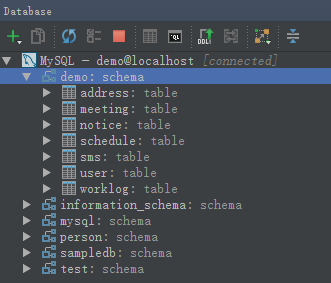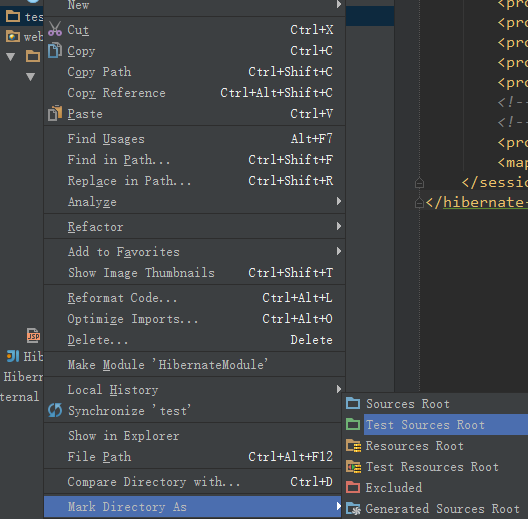Intellij IDEA的Hibernate简单应用
1、创建数据库及其表
create database demo;
use demo;
CREATE TABLE `user` (
`id` int(10) unsigned NOT NULL AUTO_INCREMENT,
`username` varchar(50) DEFAULT NULL,
`password` varchar(50) DEFAULT NULL,
`email` varchar(50) DEFAULT NULL,
PRIMARY KEY (`id`),
UNIQUE KEY `ID` (`id`),
KEY `ID_2` (`id`)
) ENGINE=InnoDB AUTO_INCREMENT=11 DEFAULT CHARSET=utf8
2、Intellij IDEA连接数据库











1)点击IDEA主界面右边的Database,点击“+”号,选择Data Source -> 选择对应的数据库,我这里选择的是MySQL。

2)输入需要用到的数据库的名称,比如demo,输入用户名和密码,点击“Test Connection‘,测试连接数据库是否成功。

3)数据库连接成功,点击”OK“,最后点击”Apply“和”OK“即可。

4)连接成功后,显示所有数据库及其表格。

5)随意点击一个表中的某个字段,即可查看到表格内容,比如user表。Data为表格内容,Text为生成表格的SQL语句。

3、使用Intellij IDEA13创建Hibernate
1)创建一个空白Project,名为:HibernateProject。
2)创建一个Module,名为:HibernateModule,选择“Web Application”和“Hibernate”。选择“create default hibernate configuration in project configuration”和“Download”,点击“Configure”,由于后面需要用到struts2,如果使用最新的Hibernate版本的话,貌似有些不兼容,所以这里选择Hibernate 3.6.10-3.6.10。确定即可。IDEA会自动下载相关的Jar包,并自动生成一个hibernate.cfg.xml配置文件。

3)调整一个项目的结构,将lib文件夹移动到web/WEB-INF路径下,在web/WEB-INF路径下生成一个文件夹classes。快捷键:Ctrl + Alt + Shift + S ,弹出Project Module。配置Paths和Dependencies。


4)将额外需要的JAR包复制到lib文件夹中,比如MySQL驱动包mysql-connector-java-5.1.22-bin.jar,测试包junit-4.10.jar。
5)根据数据库demo中的user表,生成UserEntity类。有两种生成方式,一种是生成UserEntity类并生成相应的配置文件UserEntity.hbm.xml 文件。另外一种是利用标注的方式进行数据库表与实体类的属性的匹配。这里选择第二种方式。
选择左边的Persistence,选择对应的Module的hibernate.cfg.xml,注意选择的是图标是数据库样式的,右键 -> Generate Persistence Mapping -> By Database Schema。

选择数据库源,就是刚刚测试连接的数据库;输入包名,它会自动创建包的;由于这里只是简单的演示如何利用Hibernate操作数据库,所以只是简单的选择其中一个表来做实验,比如选择demo.user。并且将右下方的“Generate Column Properties”勾上。如果选择的是第一种操作方式,则将右下方的“Generate Separate XML per Entity”勾选上,即为每一个表所对应的实体类生成一个配置文件。确定即可。

6)自动生成的实体类UserEntity。
package com.yyq.dao; import javax.persistence.*; @Entity @Table(name = "user", schema = "", catalog = "demo") public class UserEntity { private int id; private String username; private String password; private String email; @Id @Column(name = "id", nullable = false, insertable = true, updatable = true, length = 10, precision = 0) public int getId() { return id; } public void setId(int id) { this.id = id; } @Basic @Column(name = "username", nullable = true, insertable = true, updatable = true, length = 50, precision = 0) public String getUsername() { return username; } public void setUsername(String username) { this.username = username; } @Basic @Column(name = "password", nullable = true, insertable = true, updatable = true, length = 50, precision = 0) public String getPassword() { return password; } public void setPassword(String password) { this.password = password; } @Basic @Column(name = "email", nullable = true, insertable = true, updatable = true, length = 50, precision = 0) public String getEmail() { return email; } public void setEmail(String email) { this.email = email; } @Override public boolean equals(Object o) { if (this == o) return true; if (o == null || getClass() != o.getClass()) return false; UserEntity that = (UserEntity) o; if (id != that.id) return false; if (email != null ? !email.equals(that.email) : that.email != null) return false; if (password != null ? !password.equals(that.password) : that.password != null) return false; if (username != null ? !username.equals(that.username) : that.username != null) return false; return true; } @Override public int hashCode() { int result = id; result = 31 * result + (username != null ? username.hashCode() : 0); result = 31 * result + (password != null ? password.hashCode() : 0); result = 31 * result + (email != null ? email.hashCode() : 0); return result; } }
7)配置hibernate.cfg.xml 如下。
<?xml version='1.0' encoding='utf-8'?> <!DOCTYPE hibernate-configuration PUBLIC "-//Hibernate/Hibernate Configuration DTD//EN" "http://www.hibernate.org/dtd/hibernate-configuration-3.0.dtd"> <hibernate-configuration> <session-factory> <property name="connection.url">jdbc:mysql://localhost:3306/demo</property> <property name="connection.driver_class">com.mysql.jdbc.Driver</property> <property name="connection.username">root</property> <property name="connection.password">123456</property> <property name="current_session_context_class">thread</property> <property name="show_sql">true</property> <property name="hbm2ddl.auto">update</property> <!-- DB schema will be updated if needed --> <!-- <property name="hbm2ddl.auto">update</property> --> <property name="dialect">org.hibernate.dialect.MySQLDialect</property> <mapping class="com.yyq.dao.UserEntity"/> </session-factory> </hibernate-configuration>
8)生成测试路径。在Module路径下生成一个文件夹,与src同级,名为test,点击文件夹test,右键,选择Mark Directory As - > Test Sources Root。

9)生成测试类。
package com.yyq; import com.yyq.dao.UserEntity; import org.hibernate.Session; import org.hibernate.SessionFactory; import org.hibernate.Transaction; import org.hibernate.cfg.Configuration; import org.junit.Before; import org.junit.Test; public class DAOTest { Configuration config = null; SessionFactory sessionFactory = null; Session session = null; Transaction tx = null; @Before public void init() { config = new Configuration().configure("/hibernate.cfg.xml"); sessionFactory = config.buildSessionFactory(); session = sessionFactory.openSession(); tx = session.beginTransaction(); } //增加 @Test public void insert() { UserEntity ue = new UserEntity(); ue.setUsername("Anny"); ue.setPassword("123"); ue.setEmail("Anny@163.com"); session.save(ue); tx.commit(); } //修改 @Test public void update() { UserEntity user = (UserEntity) session.get(UserEntity.class, new Integer(2)); user.setUsername("Penny"); session.update(user); tx.commit(); session.close(); } //查找 @Test public void getById() { UserEntity user = (UserEntity) session.get(UserEntity.class, new Integer(8)); tx.commit(); session.close(); System.out.println("ID号:" + user.getId() + ";用户名:" + user.getUsername() + ";密码:" + user.getPassword() + ";邮件:" + user.getEmail()); } //删除 @Test public void delete() { UserEntity user = (UserEntity) session.get(UserEntity.class, new Integer(6)); session.delete(user); tx.commit(); session.close(); } }
10)运行测试类,可以一个一个方法的进行运行,也可以在类名处将所有的测试方法都一起运行。全部运行成功!

11)项目结构图。

4、Hibernate与Struts2整合
1)配置web.xml,这与普通的Struts2程序一样。
<?xml version="1.0" encoding="UTF-8"?> <web-app xmlns="http://java.sun.com/xml/ns/javaee" xmlns:xsi="http://www.w3.org/2001/XMLSchema-instance" xsi:schemaLocation="http://java.sun.com/xml/ns/javaee http://java.sun.com/xml/ns/javaee/web-app_3_0.xsd" version="3.0"> <display-name>Struts2AndHibernate</display-name> <filter> <filter-name>struts2</filter-name> <filter-class>org.apache.struts2.dispatcher.ng.filter.StrutsPrepareAndExecuteFilter</filter-class> </filter> <filter-mapping> <filter-name>struts2</filter-name> <url-pattern>/*</url-pattern> </filter-mapping> <welcome-file-list> <welcome-file>index.jsp</welcome-file> </welcome-file-list> </web-app>
2)将相关的Jar包复制到lib文件夹下。

3)创建一个名为ListAllAction.java文件。
package com.yyq.action; import com.googlecode.s2hibernate.struts2.plugin.annotations.SessionTarget; import com.googlecode.s2hibernate.struts2.plugin.annotations.TransactionTarget; import com.opensymphony.xwork2.ActionSupport; import com.yyq.dao.UserEntity; import org.hibernate.Session; import org.hibernate.Transaction; import java.util.List; public class ListAllAction extends ActionSupport { //使用@SessionTarget标注得到Hibernate Session @SessionTarget private Session session = null; //使用@TransactionTarget标注得到Hibernate Transaction @TransactionTarget private Transaction transaction = null; private List<UserEntity> users; public String list(){ try{ //得到user表中的所有记录 users = session.createCriteria(UserEntity.class).list(); transaction.commit(); session.close(); return SUCCESS; }catch (Exception e){ e.printStackTrace(); return ERROR; } } public List<UserEntity> getUsers(){ return users; } public void setUsers(List<UserEntity> users){ this.users = users; } }
4)修改index.jsp文件以显示后台数据库的数据获取情况。
<%@ taglib prefix="s" uri="/struts-tags" %> <%@ page contentType="text/html;charset=UTF-8" language="java" %> <html> <head> <title>显示数据</title> </head> <body> <table> <tr> <th>ID</th> <th>用户名</th> <th>密码</th> <th>邮箱</th> </tr> <s:iterator value="users" var="obj"> <tr> <td><s:property value="id"/></td> <td><s:property value="username"/></td> <td><s:property value="password"/></td> <td><s:property value="email"/></td> </tr> </s:iterator> </table> </body> </html>
5)配置struts.xml文件。
<?xml version="1.0" encoding="UTF-8"?> <!DOCTYPE struts PUBLIC "-//Apache Software Foundation//DTD Struts Configuration 2.1.7//EN" "http://struts.apache.org/dtds/struts-2.1.7.dtd"> <struts> <!--s2hibernate插件里面有一个叫hibernate-default的package, 它里面的拦截器用于实现struts2+hibernate整合--> <package name="default" extends="hibernate-default"> <!--defaultStackHibernate里面的拦截器会识别出@SessionTarget,@TransactionTarget等标注, 然后将hibernate注入进去--> <default-interceptor-ref name="defaultStackHibernate"/> <default-class-ref class="com.yyq.action.ListAllAction"/> <action name="listAll" method="list"> <result>index.jsp</result> </action> </package> </struts>
6)启动Tomcat,输入:http://localhost:8080/listAll.action

7)项目结构图。





